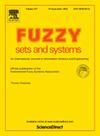L2-regularization based two-way weighted neutrosophic clustering with Manhattan and Euclidean distances
IF 2.7
1区 数学
Q2 COMPUTER SCIENCE, THEORY & METHODS
引用次数: 0
Abstract
Neutrosophic c-means clustering (NCM) is a promising algorithm to solve uncertainty and imprecision in data analysis. Despite its intensive exploration, one major challenge still needs to be addressed, i.e. how to efficiently reveal the latent structure of the dataset and improve clustering performance by discriminating the contributions of different objects and features in the clustering process. In this paper, a general neutrosophic clustering framework is proposed to address the aforementioned issue. Specifically, we develop an -regularization based two-way weighted scheme to learn the discriminative capability of different features and gauge the importance of different objects. In the proposed framework, we employ Manhattan and Euclidean distances as two different dissimilarity metrics, respectively. Additionally, we design the iterative optimization procedures to obtain neutrosophic partition, cluster centers, object weights and feature weights. Extensive experimental studies corroborate that the proposed algorithms achieve superior performance over other comparative algorithms on five synthetic and twenty real-world datasets.
基于l2正则化的曼哈顿距离和欧氏距离双向加权中性聚类
中性粒细胞c均值聚类(NCM)是解决数据分析中的不确定性和不精确性的一种很有前途的算法。尽管对聚类进行了深入的探索,但如何有效地揭示数据集的潜在结构,并通过区分聚类过程中不同对象和特征的贡献来提高聚类性能仍然是一个需要解决的主要挑战。本文提出了一种通用的嗜中性聚类框架来解决上述问题。具体来说,我们开发了一种基于l2正则化的双向加权方案来学习不同特征的判别能力和衡量不同对象的重要性。在提出的框架中,我们分别采用曼哈顿距离和欧几里得距离作为两个不同的不相似度度量。此外,我们还设计了迭代优化程序,以获得嗜中性划分、聚类中心、目标权重和特征权重。大量的实验研究证实,所提出的算法在5个合成数据集和20个真实世界数据集上取得了优于其他比较算法的性能。
本文章由计算机程序翻译,如有差异,请以英文原文为准。
求助全文
约1分钟内获得全文
求助全文
来源期刊

Fuzzy Sets and Systems
数学-计算机:理论方法
CiteScore
6.50
自引率
17.90%
发文量
321
审稿时长
6.1 months
期刊介绍:
Since its launching in 1978, the journal Fuzzy Sets and Systems has been devoted to the international advancement of the theory and application of fuzzy sets and systems. The theory of fuzzy sets now encompasses a well organized corpus of basic notions including (and not restricted to) aggregation operations, a generalized theory of relations, specific measures of information content, a calculus of fuzzy numbers. Fuzzy sets are also the cornerstone of a non-additive uncertainty theory, namely possibility theory, and of a versatile tool for both linguistic and numerical modeling: fuzzy rule-based systems. Numerous works now combine fuzzy concepts with other scientific disciplines as well as modern technologies.
In mathematics fuzzy sets have triggered new research topics in connection with category theory, topology, algebra, analysis. Fuzzy sets are also part of a recent trend in the study of generalized measures and integrals, and are combined with statistical methods. Furthermore, fuzzy sets have strong logical underpinnings in the tradition of many-valued logics.
 求助内容:
求助内容: 应助结果提醒方式:
应助结果提醒方式:


